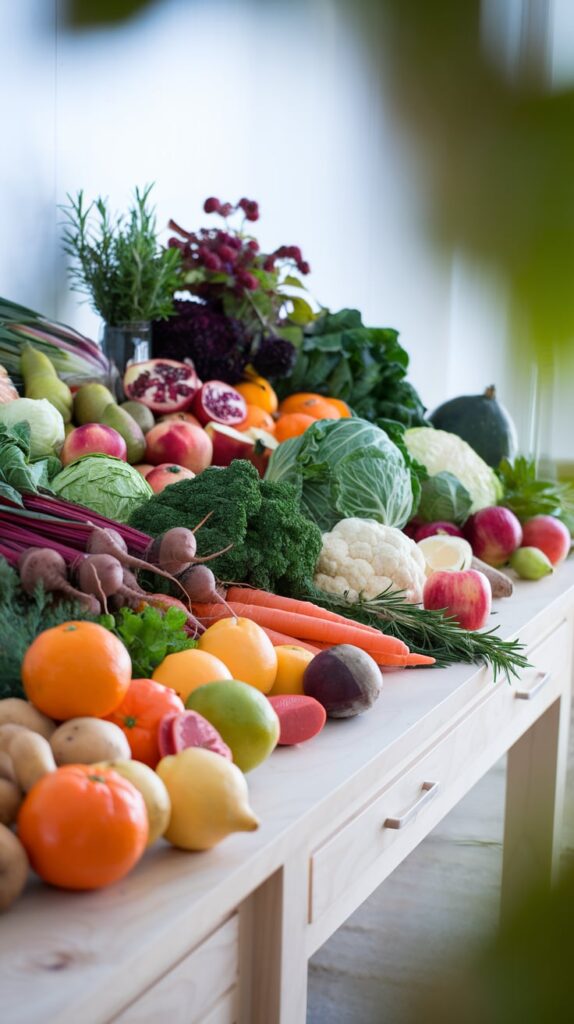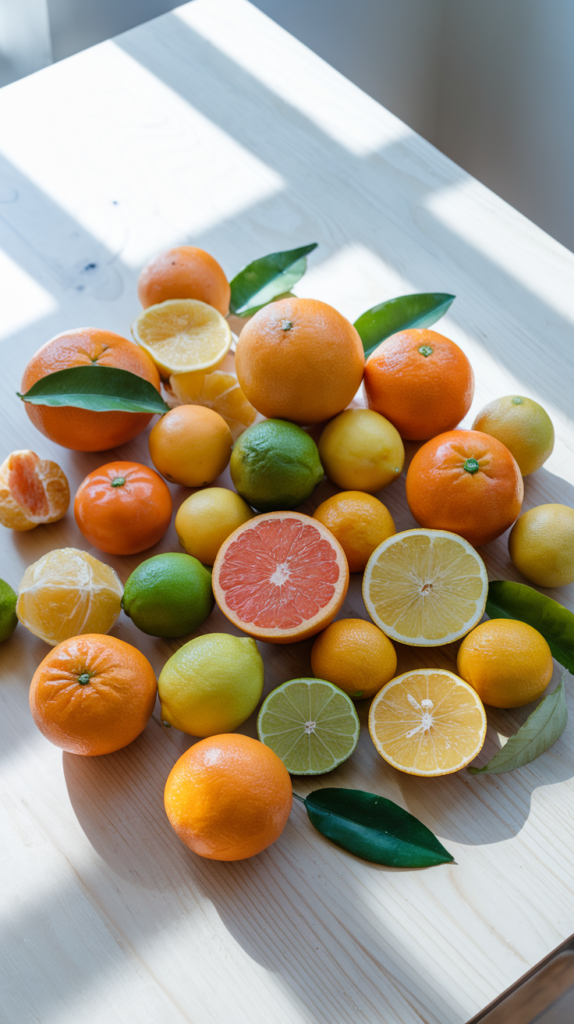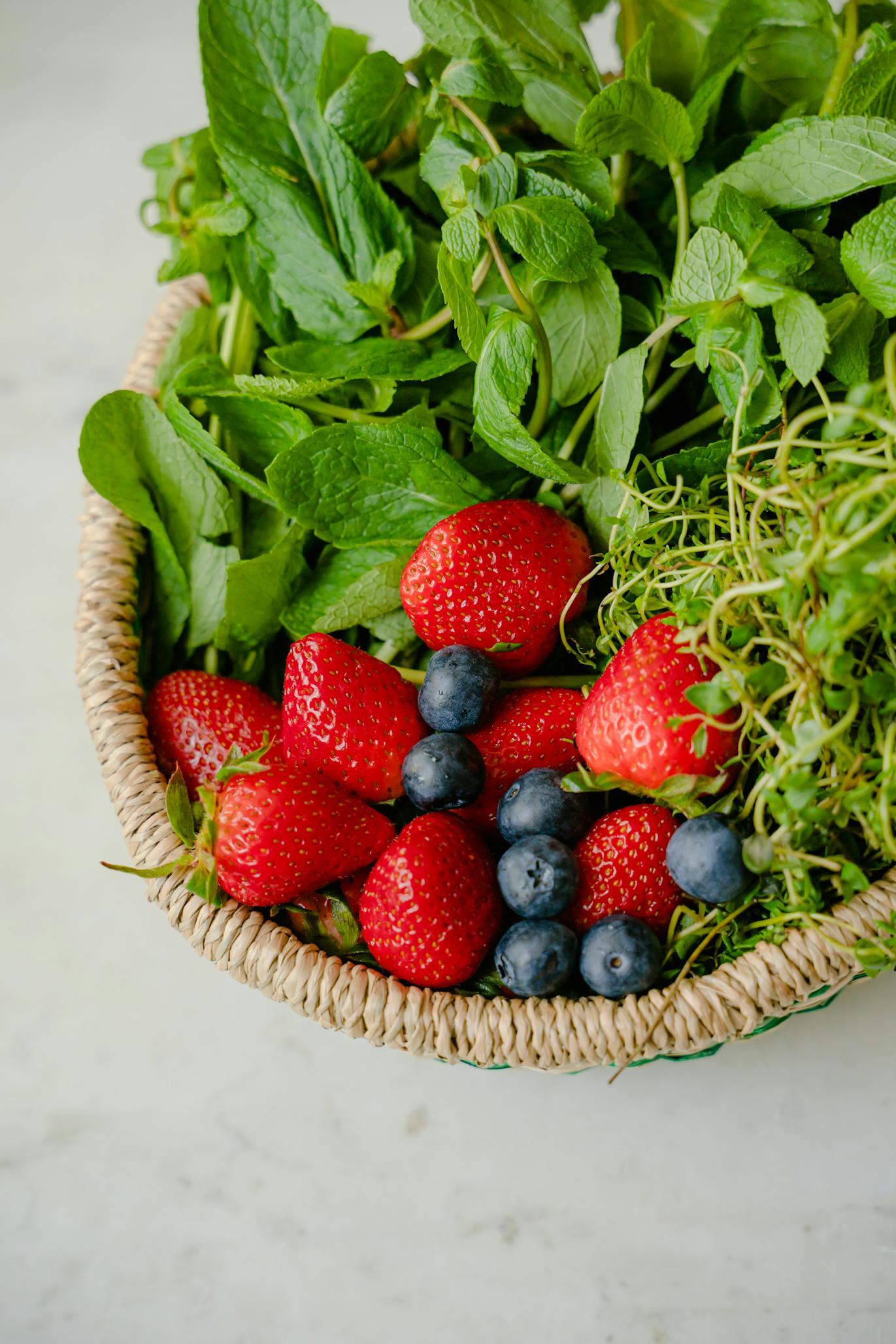What Produce Is in Season During Winter?

Part of the fun of eating a mostly plant based diet is eating seasonally and changing things up in your diet. But when the temperatures drop and the snow starts to fall, it’s easy to assume that fresh, seasonal produce disappears until spring. But this isn’t the case. Fortunately, winter has its own delightful bounty of fruits and vegetables that are at their peak during this time of year! Whether you’re cozying up with a warm meal or adding a bright, refreshing twist to your winter recipes, there are plenty of seasonal options to enjoy.
Here’s a guide to the best produce in season during winter—and some ideas for how to use and select them!
Citrus Fruits: A Burst of Sunshine

Winter is peak season for citrus fruits, making them a perfect way to brighten up the shorter, darker days. Citrus smells always make me feel happy and invigorated which is a definite plus! I’m so glad oranges, grapefruits, lemons, limes, and tangerines (like clementines and mandarins) are at their juiciest and most flavorful in winter.
How to use them:
Add orange slices to a salad for a sweet and tangy kick, enjoy a warm cup of lemon tea, or snack on a bowl of easy-to-peel clementines. Freshly squeezed grapefruit juice is also a refreshing morning pick-me-up!
What to Look For:
- Choose fruits that feel heavy for their size, as this indicates juiciness.
- Look for bright, firm skins without soft spots or blemishes.
- Avoid fruits with dull or dry-looking rinds.
Root Vegetables: Earthy and Comforting

Root vegetables thrive in cooler weather, developing a sweet, earthy flavor as they grow. Carrots, beets, parsnips, turnips, and radishes are hearty and versatile winter staples. Something about them just feels comforting in dishes.
How to use them:
Roast a medley of root vegetables with olive oil and herbs for a comforting side dish, or use them in soups and stews to add depth and nutrition. You can even shred raw beets or carrots into salads for a pop of color and crunch.
What to Look For:
- Look for firm vegetables with smooth, unblemished skin.
- Avoid roots that are shriveled or have sprouting greens, as these indicate age.
- Choose carrots and parsnips that are smaller for a sweeter flavor.
Leafy Greens: Fresh and Nutritious

Don’t let the cold stop you from enjoying fresh greens! Winter greens like kale, spinach, collard greens, and Swiss chard can still be grown and are in their prime. These sturdy greens thrive in cool weather and are packed with nutrients.
How to use them:
I like to cook them or lightly sauté kale or collard greens with garlic and olive oil for a quick and healthy side dish, or add Swiss chard to a hearty winter soup. Spinach is perfect for smoothies, or as the base for a warm grain bowl.
What to Look For:
- Opt for greens with vibrant, crisp leaves and no signs of wilting or yellowing.
- Avoid greens with slimy or brown spots.
- Check the stems—they should look fresh and not dried out.
Cruciferous Vegetables: Crisp and Flavorful

This is the amazing cancer fighting family! Cruciferous vegetables, including cabbage, Brussels sprouts, cauliflower, and broccoli, are abundant during the winter. These cold-hardy veggies are delicious roasted, steamed, or raw so fill up on them!
How to use them:
Two of my favorites are roasted brussel sprouts with a drizzle of balsamic glaze, or a creamy cauliflower soup. Cabbage shines in slaws and stir-fries, and broccoli can be steamed, roasted, or added to pasta dishes.
What to Look For:
- Choose cabbages and Brussels sprouts that are firm and tightly packed.
- Look for broccoli and cauliflower with tight florets and bright green or creamy white colors.
- Avoid any vegetables with yellowing, browning, or mushy spots.
Winter Squashes: Sweet and Versatile

As the name suggests, winter squashes, such as butternut, acorn, delicata, and spaghetti squash, are iconic seasonal ingredients. Their sweet, nutty flavors and vibrant colors bring a comforting warmth to winter cooking.
How to use them:
Roast butternut squash for a cozy soup, stuff acorn squash with quinoa and veggies, or use spaghetti squash as a low-carb pasta alternative.
What to Look For:
- Pick squash that feels heavy for its size and has a hard, unblemished skin.
- Look for dull, matte skin rather than shiny, as shininess can indicate it was harvested too early.
- Avoid squash with soft spots, cuts, or cracks.
Fruits That Last Through Winter

There are a few seasonal fruits that are great winter keepers like apples, pears, and pomegranates, either freshly harvested or stored to maintain their quality through the colder months that you can still enjoy.
How to use them:
Slice apples and pears for snacking, bake them into pies or crisps, or use pomegranate seeds to garnish salads and desserts.
What to Look For:
- Choose apples and pears that are firm with smooth, unbruised skin.
- Look for pomegranates with vibrant, unbroken skin and a heavy feel, which indicates juicy seeds inside.
- Avoid fruits with wrinkling or soft spots.
Herbs: A Pop of Fresh Flavor

Don’t forget about fresh herbs like rosemary, thyme, parsley, and sage, if you can find them, which can elevate your winter dishes with their aromatic flavors. Of course you can always use dried herbs as well, but having fresh ones during winter really seem to elevate my mood.
How to use them:
Add rosemary to roasted vegetables, sage to a creamy sauce, or parsley as a fresh garnish for soups and stews.
What to Look For:
- Look for herbs with bright, vibrant leaves and no signs of wilting.
- Stems should be firm, not slimy or dried out.
- Sniff the herbs—the aroma should be strong and fresh, not faint or musty.
Why Choose Seasonal Produce?
Eating seasonal produce gives you a rotating variety of fruits, vegetables and herbs throughout the year so that you don’t feel like you are always eating the same thing. The produce is at its peak of freshness, taste and flavor when eaten in it’s appropriate season, and the big bonus is seasonal produce tends to be more affordable. This sounds like a win all around!

I hope this was helpful and you will explore and enjoy all that the winter season has available! Bon apetite!
To your health and happiness!







